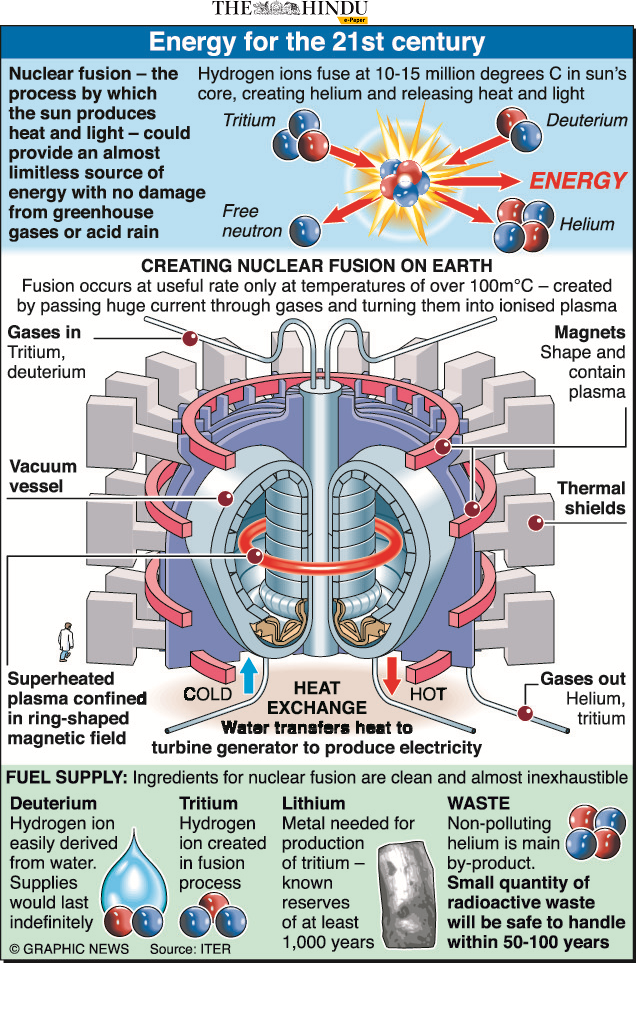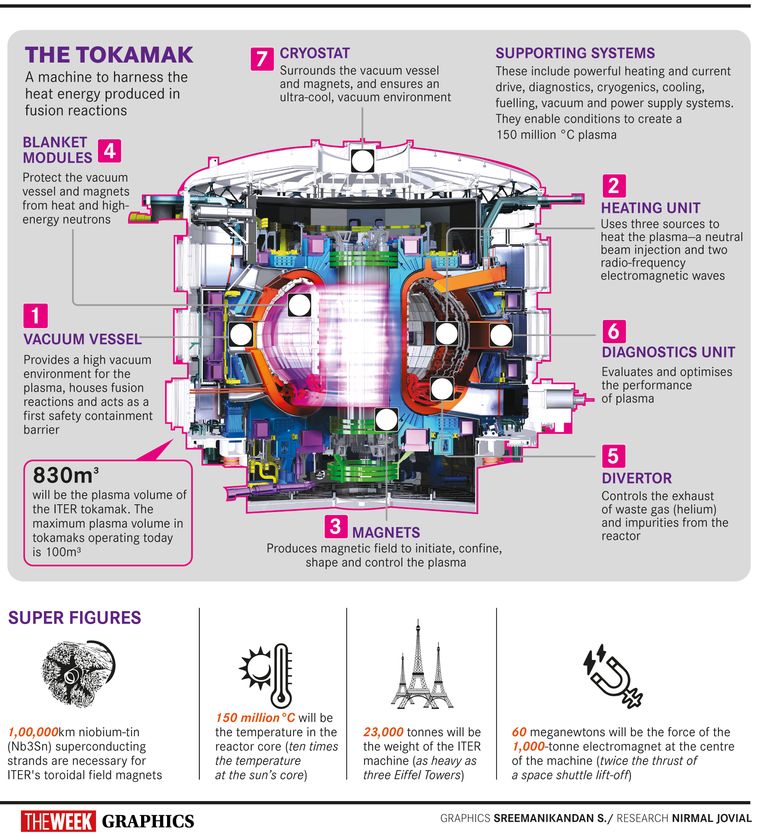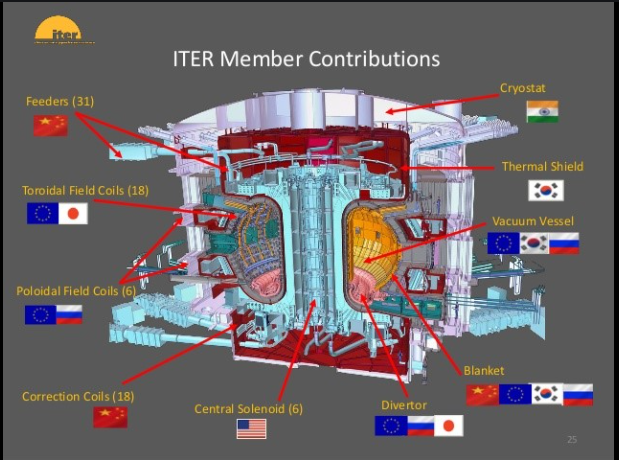ForumIAS announcing GS Foundation Program for UPSC CSE 2025-26 from 19 April. Click Here for more information.
Contents
- 1 Introduction
- 2 What is thermonuclear fusion?
- 3 How nuclear fusion will occur in stars?
- 4 What are Tokamaks?
- 5 What are the famous nuclear fusion projects around the world?
- 6 How is Nuclear Fusion different from Nuclear Fission?
- 7 What are the advantages of nuclear fusion?
- 8 What are the challenges associated with thermonuclear fusion?
| For 7PM Editorial Archives click HERE → |
Introduction
Scientists in the Joint European Torus (JET) facility, United Kingdom have said that they have achieved a new milestone in producing energy from nuclear fusion. They sustained a super-hot plasma for 5 seconds and produced 59 Mega Joules (MJ) of energy from thermonuclear fusion. This is more than double the record created in 1997 which produced 21.7 MJ of energy in 4 seconds. The record and scientific data from this is a major boost for the International Thermonuclear Experimental Reactor (ITER), the larger and more advanced version of the JET.
What is thermonuclear fusion?

Nuclear fusion is defined as the process of combining several small nuclei into one large nucleus with the subsequent release of huge amounts of energy. A specific case of fusion is the process by which hydrogen atoms combine to produce helium, and release immense energy in light and radiation.
The most efficient fusion reaction in the laboratory setting is between two hydrogen isotopes, deuterium (D) and tritium (T). Deuterium, also called heavy hydrogen, has a neutron and a proton in its nucleus. Tritium has two neutrons and one proton. The D-T fusion reaction produces the highest energy gain at the ‘lowest’ temperatures.
Nuclear fusion is possible only at extremely high temperatures and high pressure to push the hydrogen nuclei closer to fuse with each other. Hence, it is also called as ‘Thermonuclear reaction or fusion’.
| Read more: Clean Energy from nuclear fusion is our Planet’s best hope |
How nuclear fusion will occur in stars?
In a nuclear fusion reaction, lighter atoms of hydrogen fuse to produce slightly heavier atoms like helium. Ordinarily, these atoms cannot fuse. The like charges of the electron clouds surrounding the atoms would repulse and keep them at bay from coming too close.
In the core of the stars, the temperature is around 15 million Kelvins. All the electrons are ripped away at these temperatures, forming what is known as plasma, often referred as the fourth state of matter. Plasma is hot, charged gas made of positive ions and free-moving electrons.
In the sizzling heat at the core of the Sun with the intense pressure and dense core, the plasma of hydrogen fuse with each other to form helium. This will spew colossal energy in the form of light and heat.
The essential condition to achieve nuclear fusion in the laboratory
Hence, three essential conditions are required to achieve nuclear fusion in a laboratory. These are a) Extreme high temperature, b) Sufficient plasma particle density, c) Sufficient confinement time (to hold the plasma, without expanding and containing within a defined volume). These conditions are very difficult to establish and sustain in a controlled manner and pose a big engineering challenge.
| Read more: A leap forward for fusion power |
What are Tokamaks?

Scientists first thought about producing energy from controlled nuclear fusion in 1940s. Both the USSR and the US stepped up their fusion research in 1950s. Soon, the Soviets came up with a viable design to kindle and sustain nuclear fusion—the Tokamak.
The thermonuclear fusion process is established in fusion reactors such as the Tokamaks. Although alternative designs such as z-pinch and stellarator have been designed and tested, tokamaks are still considered the best for achieving fusion.
‘Tokamak’ is an acronym for Russia term which translates into ‘toroidal chamber with magnetic coils’. The Soviet scientists theorised that if one can create a magnetic field in the shape of a torus (doughnut shape) then the scorching plasma could be contained. The scalding of the walls of the container from the intense heat of plasma could be prevented.
| Read more: Nuclear fusion could be close enough to start blue-sky gazing |
What are the famous nuclear fusion projects around the world?
International Thermonuclear Experimental Reactor (ITER)

The ITER fusion reaction is based on the isotopes of hydrogen (deuterium and tritium). ITER will be the world’s largest tokamak. Thirty-five countries, including India, Russia, the United States, the United Kingdom, China, European Union, are collaborating to jointly build the largest Tokamak as part of the International Thermonuclear Experimental Reactor (ITER). Scientists, engineers and technicians from all the 35 participating countries are working on the site and getting hands-on operational experience and training.
After years of ups and downs since March 2020, the machine assembly is underway in southern France. With the installation of the Cryostat, a device to cool the reactor, covering the assembly is slated to be completed by 2025.
The first plasma is expected to be produced at the end of 2025 or early 2026. After testing and troubleshooting, energy production might commence in 2035. The plant is expected to generate 500 MW power and consume 50 MW for its operation, resulting in a net 450 MW power generation.
China’s Experimental Advanced Superconducting Tokamak (EAST) or Artificial Sun
The purpose of the EAST is to replicate the process of nuclear fusion, which is the same reaction that powers the sun. Hence, called the artificial sun. EAST is part of ITER. Recently, China’s EAST sustained the plasma at 70 million degrees Celsius for 1,056 seconds in January 2022.
| Read more: China turns on ‘artificial sun’ |
What has been the progress in India with respect to Nuclear Fusion technology?
Way back in 1955, in the first ‘Atoms for Peace’ meeting in Geneva, Homi J. Bhabha saw a future in energy coming from thermonuclear fusion.
The Institute for Plasma Research (IPR) in Gandhinagar and the Hot Plasma Project at Saha Institute of Nuclear Physics (SINP), Kolkata, took the lead in nuclear fusion research in India. The IPR owns two operational tokamaks – ADITYA and Steady-State Tokamak (SST)-1.
ADITYA Tokamak: It is the first indigenously designed and built tokamak of the country. It was commissioned in 1989.
SST-1: It is under design and fabrication at the IPR. The objectives are a) Studying the physics of the plasma processes in tokamak under steady-state conditions, b) Learning technologies related to the steady-state operation of the tokamak.
How is Nuclear Fusion different from Nuclear Fission?

The advantages of nuclear fusion compared to fission include,
Do not pose danger like nuclear fission reactors: Unlike fission reactors, fusion reactors like the tokamaks do not pose the dangers of a radioactive leak. The by-products of fusion reaction is helium which is not radioactive.
Provides more energy: Fusion reactors produce four times more energy than nuclear fission reactions.
| Must read: [Yojana October Summary] Energy Security: Nuclear Power – Explained, pointwise |
What are the advantages of nuclear fusion?
Abundant energy: Gram for gram, thermonuclear power produces four million times more energy than burning coal. A kilogram of fusion fuel contains about 10 million times as much energy as a kilogram of coal, oil or gas e.g., if four grams of hydrogen can be fused into helium, it can light a 60-watt light bulb for over 100 years.
Sustainability: Fusion fuels are widely available and nearly inexhaustible e.g., deuterium can be distilled from all forms of water.
Non-pollutant: Nuclear fusion does not emit harmful toxins like CO2 or other greenhouse gases. The only waste product from nuclear fusion is the harmless helium which is an inert and non-toxic gas.
No risk of meltdown: Any disturbance/malfunction will lead to the cool down of plasma within seconds and the reaction stops.
What are the challenges associated with thermonuclear fusion?
First, although there are many experimental tokamaks worldwide none has demonstrated net energy production more than the input. This is because lot of energy is consumed in creating high temperatures.
Second, one of the critical challenges in the Tokamak is the sudden appearance of plasma instabilities.
Third, triggering fusion reactions requires temperatures of 100 million degrees Celsius, and pressures of 100 billion Earth atmospheres.
Fourth, currently, the nuclear fusion process is triggered by the nuclear fission process. However, this process is very destructive, as the fission explosion also releases lethal radiation that may last for millennia.
Scientists are working hard to overcome the engineering challenges in creating and maintaining a stable nuclear fusion process. If scientists are able to overcome these challenges, nuclear fusion could meet humanity’s energy needs for millions of years. Harnessing energy from controlled nuclear fusion reactions could play a vital role in mitigating climate change. The recent achievements provide an encouraging way forward in this regard.




